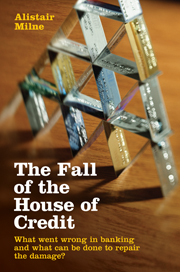 The Fall of the House of Credit
The Fall of the House of Credit Published online by Cambridge University Press: 23 December 2009
The investment banking activity known as ‘structured credit’ created a zoo of new tranched products. The last chapter looked closely at one particular example, a collateralized loan obligation (CLO) deal, and briefly reviewed other types of transaction, including the very dubious restructured deals employing as collateral the riskier tranches of other structured credit deals. These transaction deals made an immediate profit and also provided credit to many types of risky borrower who found it difficult to access normal bank credit.
Investment banks in effect began to compete directly with commercial banks in the provision of credit, at the lower end of the credit quality spectrum. They engaged in a ‘hunt for yield’ – that is, a search for high-yield credit assets that could be bought, packed in these arbitrage structures and yield an immediate accounting gain. This hunt for yield resulted in a massive credit creation, especially in three areas: sub-prime mortgages and home-equity loans, commercial property and the ‘leveraged loans’ used for private equity buyouts.
A common feature of all these transaction structures was their employment of leverage. Leverage was the reason for using similar tranching to that of the more established MBS and ABS. By creating a large proportion of safe AAA tranches (in retrospect not always so safe, especially in the case of the dubious restructured deals), the returns to the remaining higher risk tranches were enhanced. In an environment of strong economic growth and rising prices for property and other assets, these higher-risk tranches offered high returns and so appealed to some investors.
To save this book to your Kindle, first ensure no-reply@cambridge.org is added to your Approved Personal Document E-mail List under your Personal Document Settings on the Manage Your Content and Devices page of your Amazon account. Then enter the ‘name’ part of your Kindle email address below. Find out more about saving to your Kindle.
Note you can select to save to either the @free.kindle.com or @kindle.com variations. ‘@free.kindle.com’ emails are free but can only be saved to your device when it is connected to wi-fi. ‘@kindle.com’ emails can be delivered even when you are not connected to wi-fi, but note that service fees apply.
Find out more about the Kindle Personal Document Service.
To save content items to your account, please confirm that you agree to abide by our usage policies. If this is the first time you use this feature, you will be asked to authorise Cambridge Core to connect with your account. Find out more about saving content to Dropbox.
To save content items to your account, please confirm that you agree to abide by our usage policies. If this is the first time you use this feature, you will be asked to authorise Cambridge Core to connect with your account. Find out more about saving content to Google Drive.